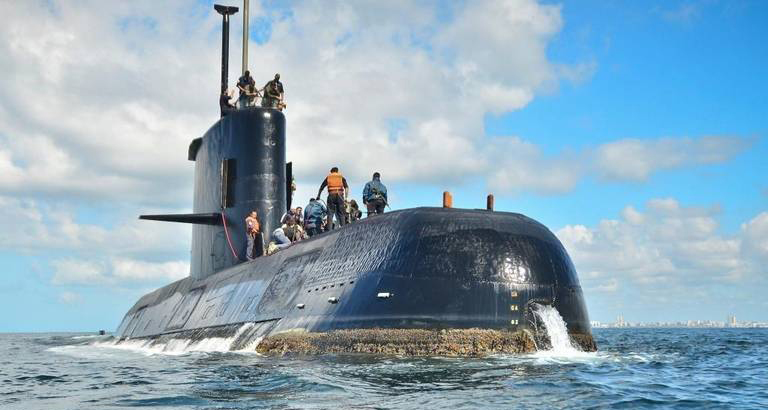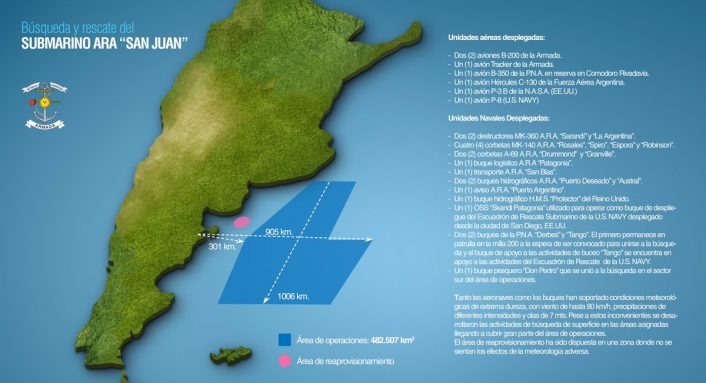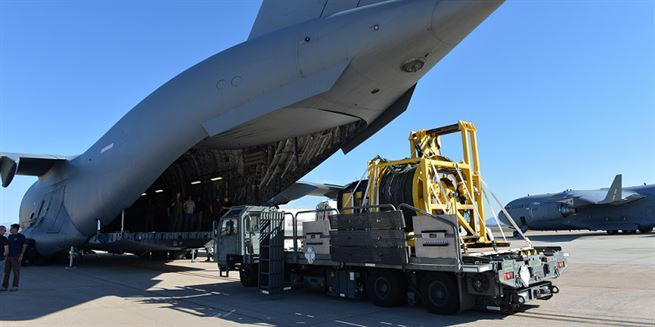Argentina says it may have received signals from missing sub
19.11.2017

This 2014 photo provided by the Argentina Navy shows the ARA San Juan, a German-built diesel-electric vessel, docked in Buenos Aires, Argentina. Argentina's Navy said Friday, Nov. 17, 2017, it has lost contact with its ARA San Juan submarine off the country's southern coast. (Argentina Navy via AP)
BUENOS AIRES, Argentina — Argentina’s Navy detected seven brief satellite calls Saturday that officials believe may have come from a submarine with 44 crew members that hadn’t been heard from in three days.
The communication attempts “indicate that the crew is trying to re-establish contact, so we are working to locate the source of the emissions,” the Navy said on its Twitter account, adding that the calls lasted between four and 36 seconds.
Argentine authorities clarified that it has not been confirmed the calls came from the submarine, the ARA San Juan, though that is the working hypothesis.
Earlier Saturday, Navy spokesman Enrique Balbi said the area being searched off the country’s southern Atlantic coast has been doubled as concerns about the fate of the submarine and its crew grew.
“We are not discounting any hypothesis,” Balbi said, adding that possibilities to explain the submarine’s disappearance include “a problem with communications” or with its power system.

The Argentine ship Comandante Espora sails off the navel base in Mar del Plata, Argentina, Saturday, Nov. 18, 2017. This ship is is part of a searching crew to find a submarine that hadn't been heard from in three days. Authorities last had contact with the German-built diesel-electric sub, the ARA San Juan, on Wednesday as it was on a voyage from the extreme southern port of Ushuaia to Mar del Plata. (Vicente Robles/AP)
Authorities last had contact with the German-built, diesel-electric sub on Wednesday as it was on a voyage from the extreme southern port of Ushuaia to Mar del Plata.
Argentine President Mauricio Macri said in a tweet that the country will use “all resources national and international that are necessary to find the submarine.”

#BREAKING: Undersea Rescue Command ordered to deploy to Argentina to support ongoing search for Argentinean Navy submarine A.R.A. San Juan -
Pledges of help came from Chile, Uruguay, Peru and Brazil, as well as the United States, which sent a NASA scientific aircraft and a Navy plane. Britain was sending a polar exploration vessel, the HMS Protector, which British officials said should arrive Sunday.
The U.S. Navy ordered its Undersea Rescue Command based in San Diego, California, to deploy to Argentina to support the search for the submarine. The command includes a remotely operated vehicle and vessels capable of rescuing people from bottomed submarines.
BREAKING @USNavy deploys Undersea Rescue Command (URC) to support search for Argentinean Navy submarine A.R.A. San Juan. URC is sending Submarine Rescue Chamber (SRC) & Remotely Operated Vehicle (ROV), then Pressurized Rescue Module (US Navy file footage
Adm. Gabriel Gonzalez, chief of the Mar del Plata Naval Base, said they are coordinating “with units from the United Kingdom and the United States.” Britain and Argentina fought a war in 1982 over the Falklands Islands, which are called the Malvinas in Argentina.




#BREAKING: Submarine rescue chamber and other assets being mobilized at @MCASMiramarCA to support search for Argentinean Navy submarine A.R.A. San Juan
Relatives of the crew members gathered at the Mar del Plata Naval Base in the hopes of hearing news about their loved ones.
“We feel anguish. We are reserved but will not lose our hope that they will return,” Marcela Moyano, wife of machinist Hernan Rodriguez, told television network TN.
She said she spoke with her husband when the submarine departed and is still sending him WhatsApp messages, though he has not responded.
From the Vatican, Argentine Pope Francis said he was making “fervent prayers” for the crew.
https://www.defensenews.com/naval/2...t-may-have-received-signals-from-missing-sub/
19.11.2017
This 2014 photo provided by the Argentina Navy shows the ARA San Juan, a German-built diesel-electric vessel, docked in Buenos Aires, Argentina. Argentina's Navy said Friday, Nov. 17, 2017, it has lost contact with its ARA San Juan submarine off the country's southern coast. (Argentina Navy via AP)
BUENOS AIRES, Argentina — Argentina’s Navy detected seven brief satellite calls Saturday that officials believe may have come from a submarine with 44 crew members that hadn’t been heard from in three days.
The communication attempts “indicate that the crew is trying to re-establish contact, so we are working to locate the source of the emissions,” the Navy said on its Twitter account, adding that the calls lasted between four and 36 seconds.
Argentine authorities clarified that it has not been confirmed the calls came from the submarine, the ARA San Juan, though that is the working hypothesis.
Earlier Saturday, Navy spokesman Enrique Balbi said the area being searched off the country’s southern Atlantic coast has been doubled as concerns about the fate of the submarine and its crew grew.
“We are not discounting any hypothesis,” Balbi said, adding that possibilities to explain the submarine’s disappearance include “a problem with communications” or with its power system.
The Argentine ship Comandante Espora sails off the navel base in Mar del Plata, Argentina, Saturday, Nov. 18, 2017. This ship is is part of a searching crew to find a submarine that hadn't been heard from in three days. Authorities last had contact with the German-built diesel-electric sub, the ARA San Juan, on Wednesday as it was on a voyage from the extreme southern port of Ushuaia to Mar del Plata. (Vicente Robles/AP)
Authorities last had contact with the German-built, diesel-electric sub on Wednesday as it was on a voyage from the extreme southern port of Ushuaia to Mar del Plata.
Argentine President Mauricio Macri said in a tweet that the country will use “all resources national and international that are necessary to find the submarine.”
Pledges of help came from Chile, Uruguay, Peru and Brazil, as well as the United States, which sent a NASA scientific aircraft and a Navy plane. Britain was sending a polar exploration vessel, the HMS Protector, which British officials said should arrive Sunday.
The U.S. Navy ordered its Undersea Rescue Command based in San Diego, California, to deploy to Argentina to support the search for the submarine. The command includes a remotely operated vehicle and vessels capable of rescuing people from bottomed submarines.
BREAKING @USNavy deploys Undersea Rescue Command (URC) to support search for Argentinean Navy submarine A.R.A. San Juan. URC is sending Submarine Rescue Chamber (SRC) & Remotely Operated Vehicle (ROV), then Pressurized Rescue Module (US Navy file footage
Adm. Gabriel Gonzalez, chief of the Mar del Plata Naval Base, said they are coordinating “with units from the United Kingdom and the United States.” Britain and Argentina fought a war in 1982 over the Falklands Islands, which are called the Malvinas in Argentina.
Relatives of the crew members gathered at the Mar del Plata Naval Base in the hopes of hearing news about their loved ones.
“We feel anguish. We are reserved but will not lose our hope that they will return,” Marcela Moyano, wife of machinist Hernan Rodriguez, told television network TN.
She said she spoke with her husband when the submarine departed and is still sending him WhatsApp messages, though he has not responded.
From the Vatican, Argentine Pope Francis said he was making “fervent prayers” for the crew.
https://www.defensenews.com/naval/2...t-may-have-received-signals-from-missing-sub/















